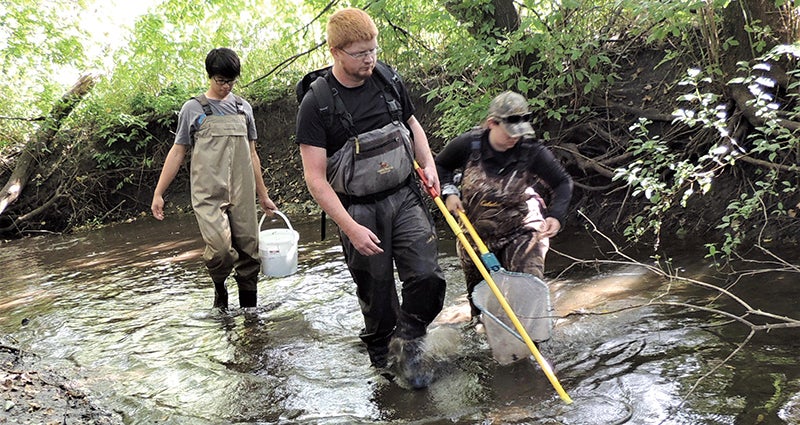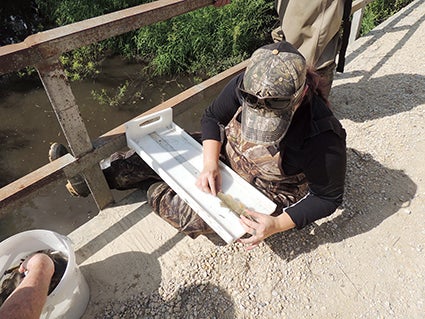Establishing water progress is large challenge
Published 8:53 am Thursday, March 30, 2017

- University of Minnesota students conduct an electrofishing survey last August on the North Branch of Dobbins Creek in Red Rock Township as part of a comprehensive water-quality project that uses Clean Water Legacy funds. Photo provided
Justin Hanson
Fields, Rivers & Streams
Minnesota taxpayers recently heard good news when state auditors reported finding that funds are being used as they were intended by the Clean Water Legacy Act.
This is not a surprise to me but we are living in a climate of government distrust and lacking transparency. It’s important to recognize the close scrutiny that the fund’s recipients go through to ensure they are following the spirit of the Clean Water Legacy Act – approved in 2008 by Minnesota voters – and all the criteria around the program’s transparency.
From a local perspective, our Mower Soil & Water Conservation District/Cedar River Watershed District office has had pretty good luck with Clean Water Fund grants. Those funds get a rigorous accounting review that actually has shifted the way we do business and track our daily work. The process has come with local growing pains and grumbling about lost efficiency but we all understand the importance of transparency. This process has been a good experience for us.
This summer, the state will offer the ninth round of Clean Water Fund grant applications. Mower SWCD/CRWD has applied every year that funding has been offered by the program. These funds have been great for our local landowners because they leverage state funding to serve the locals. Clean Water funds also serve the natural resources well as they are directed at targeted projects for improving water quality.

A University of Minnesota student measures one of the fish collected last August during an electrofishing survey on the North Branch. Photo provided
The big question remains: “Is water quality improving in Minnesota?” On small scales, we can see projects that result in water-quality improvements. Unfortunately, the size of this scale is better described as an indicator than a solution.
Since 2009, the Clean Water Fund has utilized $760 million through a three-eighths of 1 percent tax that runs through 2034. This is a remarkable amount of money that has elevated the quality of conservation work exponentially. In that time, our Mower SWCD/CRWD office has overhauled the way we target conservation practices.
Gone are the days when our office operated as a service organization alone in helping agricultural producers and landowners in the county. We used to work within the limits of USDA farm programs and hope that we had done enough good to make a difference.
Today, we pull out strategic plans and all the available data to target the most important projects that will accelerate change in water quality. Our projects today are surgically built to be the most-effective projects that we can get on the ground.
I strongly believe we are making progress. Is it showing up in the water chemistry? Not on a broad scale but I also think it’s reasonable to expect that it is going to take time to see real change on the landscape to show up in the water.
Clean Water funds are spread out over the entire state of Minnesota. That means almost 80,000 square miles of land is eligible for treatment. Not all of Minnesota needs that level of treatment but these funds are being used in every corner of the state.
It’s difficult to expect that the Cedar River State Water Trail and its tributaries are going to be cleaned up completely in 10 or 25 years from impairments that include too much sediment and excess nutrients (nitrogen and phosphorus). While the recent audits provide good transparency on the use of Clean Water funds, it’s also important for us to remain transparent in our expectations for change.
We are going to be working at this for a while. Change in water quality also is not going to come by government programs alone, and it’s unreasonable to expect significant water-quality shifts only through that way. Cultural changes to how we all influence the land and water are going to have to change as well.
That doesn’t mean change and progress aren’t happening. Every day, I see practices on the ground and hear about people’s conservation ethics. We are getting better every day but it’s never going to happen fast enough.
We all just need to keep working together on making changes and ensuring they are sustainable.
Mower SWCD provides technical assistance to landowners with conservation practices that protect land and water resources. SWCD also administers the Cedar River Watershed District to improve water quality and reduce flooding. This column runs monthly. For more, visit the Mower SWCD and CRWD websites and Facebook pages. Comments can be sent to tim.ruzek@mowerswcd.org.


